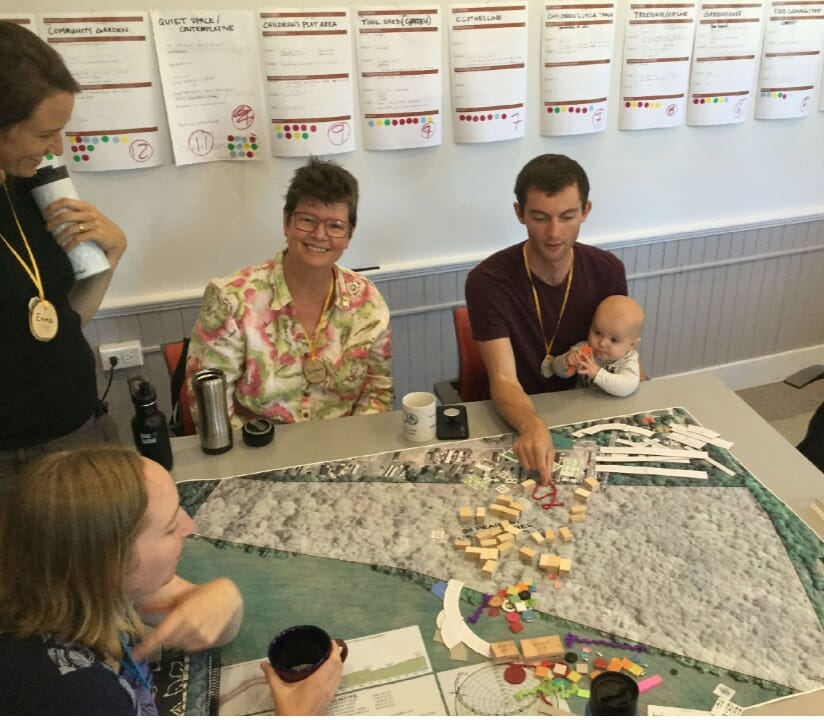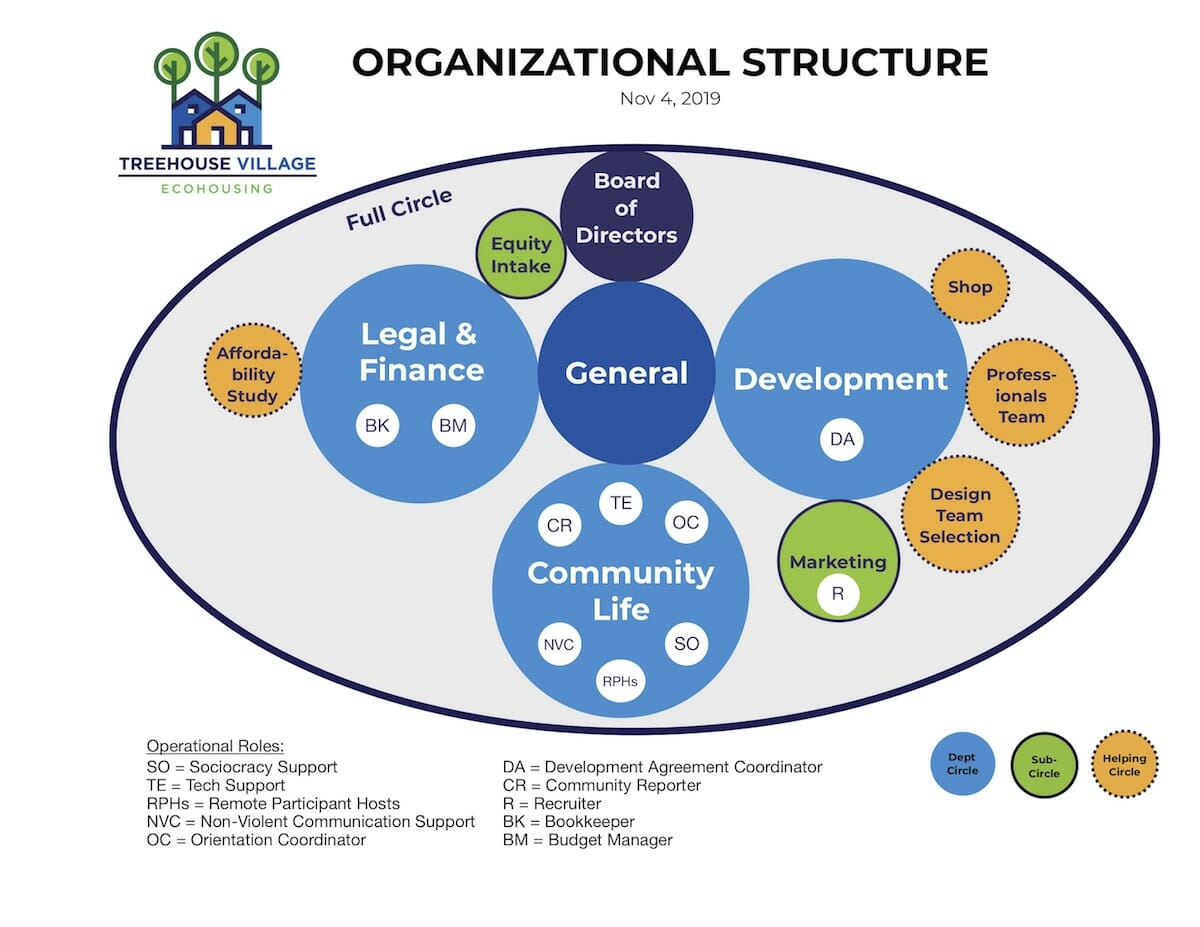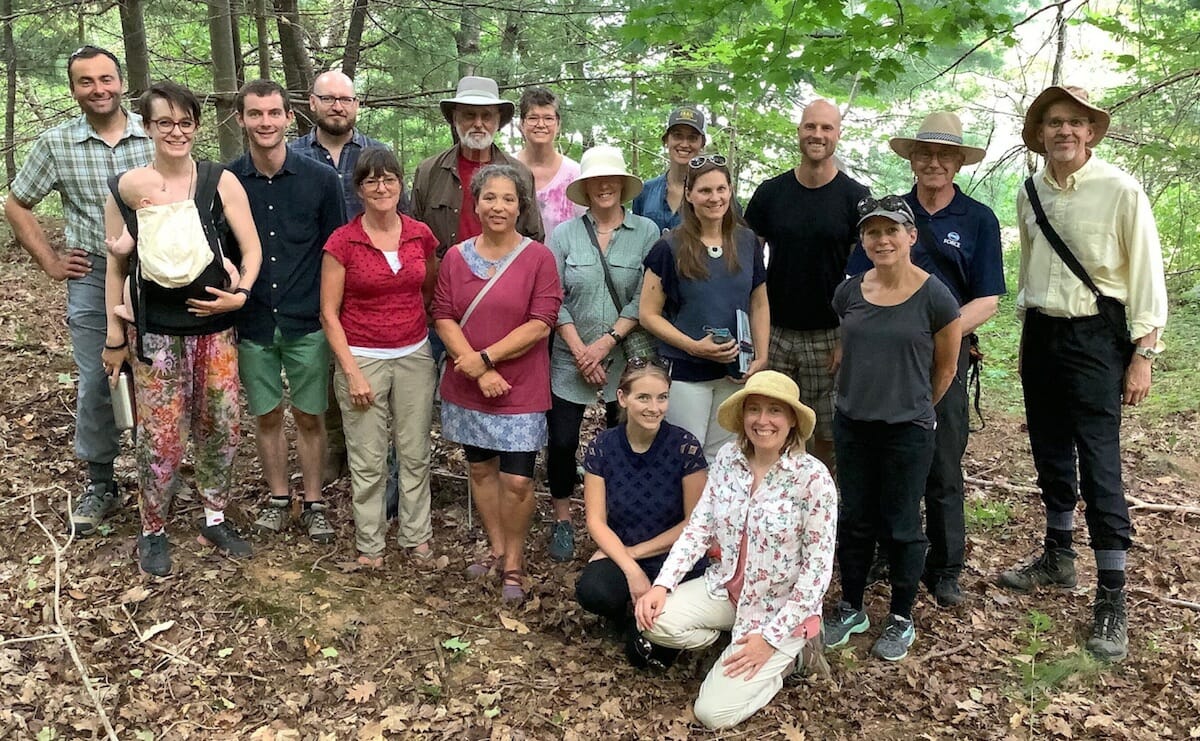“Treehouse Village Ecohousing”, Bridgewater, NS, Canada
Foundation
Treehouse Village Ecohousing is a project to build a cohousing community, the first in Atlantic Canada. It officially launched on Sept 29, 2018 with a first public meeting. The project was established with the following vision, core values, and aims:
Vision: “We envision a joyful, environmentally responsible, healthy, multi-age cohousing community in Bridgewater, NS, Canada.”
Core Values:
- “Our planet: living lightly on the earth”
- “Our neighbours: sharing resources and joy, and welcoming to all”
- “Ourselves: living in a comfortable and healthy home”
Organizational Aims:
- to build 25-30 units, medium density form (perhaps townhouses, duplexes/triplexes) and a variety of unit sizes (1, 2, 3 bedrooms); located within the boundaries of the Town of Bridgewater, connected to town services, within walking distance of important amenities and public transit; on a site (min. 5 acres) that has ample space for outdoor play and gardening
- to have modestly-sized private units and a well-equipped common house, arranged in a community-oriented design
- to have very high degree of energy efficiency (net zero or passivehaus standard)
- to be incorporated as a condominium under the NS Condominium Act
- to apply sociocratic governance using consent-based decision making
- to use quality, durable construction techniques, using universal design principles
- to create a multigenerational community which welcomes all family types and ages.
- to aim for sale prices of $200K for 1-bdrm, $250K for 2-bdrm, $300K for 3-bdrm, (all +HST).
At the moment (Nov. 2019) the Treehouse Village has 23 households, comprised of 36 adults. They are aiming to have 30 households.
Journey to sociocracy at Treehouse Village Ecohousing
After some first efforts between 2011 and 2013, Cate & Leon de Vreede decided to seriously commit to establishing a cohousing project in 2018. Between September and December 2018, the group grew to 15 households, and needed to define how it would make decisions and govern itself. Members researched using consensus, which is common in cohousing, and were also introduced to sociocracy by their cohousing consultant, Jasen Robillard. Both consensus and sociocracy were unfamiliar to most members in the group. They ordered a copy of Many Voices One Song, and and did a quick study on sociocracy (reading and web-browsing), noticing fairly quickly that it seemed to have significant advantages over consensus. Their main hesitation to adopting sociocracy was that most cohousing communities used consensus. What helped make their decision was knowing that both established and forming cohousing communities were switching over to sociocracy, and from their limited experience, they could perceive many benefits to sociocracy. They were also unsure if they could implement all the parts of sociocracy from the start (it seemed a bit daunting). The 15 households of Treehouse Village, made their very first consent decision on Dec 9, 2018, which was to adopt sociocracy as their governance and decision-making approach. This gave an excellent foundation. There was very little reluctance from members about adopting sociocracy. They have never looked back, or considered switching to another governance approach.

The implementation of sociocracy
In March 2019, they hired their cohousing consultant, Jasen Robillard, to facilitate a weekend-long workshop with all members. One of the main goals of the workshop was to establish the organizational structure. They generated the aims and domains of the general circle and 3 department circles. Those circles were then populated, selections for the key roles were done. They started working in those circles. It was an intensive way to establish the organization structure, but it worked very well. Their structure as of Nov 4, 2019 is pictured here:

The impacts of sociocracy on the community
“There is a lot we love about sociocracy! We love that it enables us to get so much work done as a group.” The project is being developed at a fast pace, and sociocracy has allowed to make well-thought-out decisions relatively quickly. It has helped each member to feel that they have a place to meaningfully contribute. The group tries to use just about all parts of sociocracy. Some are used better and more fully than others. They use the organizational structure, decision-making, agenda & minutes template, role selections, proposal forming, review terms (evaluation). They struggle with making enough time to do evaluation periodically (role and circle reviews at end of terms), but they are doing it.
Setting up aims and domains has helped clarify where work is to be done. The key roles (leader, facilitator, delegate, secretary) have brought clarity to who does what. They have been learning to trust each other to make decisions on behalf of the group (“not easy, but we are practicing and getting better at it”). They love that objections are tied to the aim, which helps keep all of them focused on the big-picture goal. “We love Sociocracy for all resources (book, website, videos), because it helps us educate new members. We appreciate how available Ted and Jerry have made themselves to us; their advice has been key.” They also had an Non-Violent Communication trainer come to do a 4-part training series with their members. That was helpful, and they would like to do more. “We do have an ‘NVC Support’ operational role in our organization. Perhaps in part due to the NVC training, or to the sociocratic process, we have had very little conflict in our project. We are glad that sociocracy and NVC are so complimentary.”
There are still some challenges they need to overcome while educating new and seasoned members about sociocracy:
(1) The concept “good enough for now, safe enough to try” brings some questions: How can “good enough for now” be applied to permanent architectural design decisions that can’t be reversed later?; and the concept could be taken to mean that mediocrity is acceptable- “if you don’t strive for excellence you will never reach mediocrity.”
(2) How can space be made to do all the parts of sociocracy well while still moving their development forward? There is so much business to accomplish in this development phase, that it is hard to find time to do all the parts of sociocracy well.
(3) People sometimes find the meetings don’t leave enough space for chatting and getting together for sharing and talking. (e.g. At times, “Quick reaction rounds” would be better if they were just “Reaction rounds” so that people had the opportunity to discuss their thoughts even if they were going to consent to the item).“I can’t tell you how many times I’ve heard a member talk about feeling poorly or low energy during the check-in round, and then say they felt so much better during their check-out round.”
The future of sociocracy
They intend to keep using sociocracy post-move-in. They do not foresee a time when Treehouse Village will stop using sociocracy. Probably it will serve even better once they move in together, because then they will be doing the on-going management of the community (a lot of policy formation and development).
If the Treehouse Village community could go back in time, they would have gotten more ELC study groups going as more members joined. Wondering if they should make it “mandatory” to becoming an equity member.
Cate’s advice for a team that is starting with sociocracy is: 1) to do it from the very beginning (if you can). 2) Just start using (parts of) it; don’t worry if you don’t have everything figured out or lined up. Just start and you will learn as you go. 3) Support each other; learn together while doing. “We are getting a ton of work done, and working well with each other. Highly recommended sociocracy to other forming cohousing communities”.

Treehouse Village Case study completed for SOLT 12 written by Kristina Čelkė and Cornelia Stoeri. Interviewed Cate de Vreede and Abe Ross.
Links: www.treehousevillage.ca


Leave a Reply
You must be logged in to post a comment.